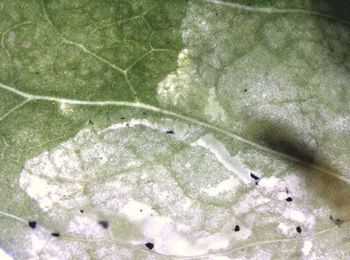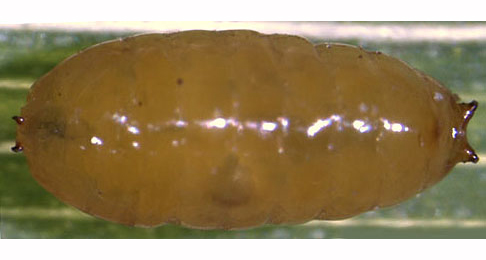|
||||||
|
PISUM. Pea. [Fabaceae] |
|
Two species of Pisum are recorded in Britain. These include the introduced Garden Pea (P. sativum). Eight British miners miners are recorded on Pisum. A key to the European miners recorded on Pisum is provided in Bladmineerders van Europa. |
Key for the identification of the known mines of British |
1a > Stem miner: An external stem mine. Pupation in the stem, near or even below ground level, with the anterior spiracles projecting through the epidermis (Spencer, 1976: 72-3). |
|
Ophiomyia orbiculata (Hendel, 1931) [Diptera: Agromyzidae]. |
1b > Leaf-miner |
2a > Leaf-miner: A distinctive mine primarily above mid-rib, with irregular short lateral offshoots into leaf blade. Pupation external (Spencer, 1972: 51 (fig. 172), 55; Spencer, 1976: 270, 271 (fig. 486)). Branched, whitish, upper-surface corridor; main axis overlying the midrib; side branches overlying the main lateral veins. (In Campanula and Phyteuma the mine is much less branched, sometimes nothing more than a corridor on top of the midrib). Frass in rather long strings. Usually the mines begins as a long and narrow, shallow, tortuous lower-surface corridor that ends upon the midrib but otherwise is not associated with the leaf venation. Often this initial corridor is filled with callus, and then even less conspicuous. Pupation outside the mine. A linear mine on the upper surface, usually following the midrib and showing side branches along the veins. The frass is in strings. |
|
Liriomyza strigata (Meigen, 1830) [Diptera: Agromyzidae]. |
| 2b > Leaf-miner: Corridor-blotch
mine, normally dorsal; usually whitish; in small leaves it lies
characteristically in the centre of the leaf often touching the
petiole; in larger leaves it lies to one side of the mid-rib. Frass
deposited in green clumps near the leaf margin. Pupation usually
external, sometimes in a separate pupation mine.
Oviposition whitin the leaf, at the lower surface. The first part of the mine is a long, sometimes very long, corridor, that mostly will be overrun by the later developments. Generally this corridor is directed, frequently guided by a thick vein, to the midrib. The next section of the mine is large, irregular blotch overlying the basal section of the midrib. Locally large chunks of midrib tissue are consumed. From this central blotch excursions are made into the leaf blade: generally upper-surface, less often lower-surface and locally full-depth. In plants with narrow leaves, like Diplotaxis, the mine may occupy the entire width of the leaf. Often several larvae together in a mine. Frass blackish green, powdery, in clouds, sometimes along the sides of the corridors, later more in the periphery of the mine and in the end of extensions of the blotch, sometimes seemingly absent. (Often the frass can only be seen after the mine has been opened). Pupation generally in the ground, rarely within he leaf, in a short mine without frass. Hendel (1928a) described the biology, larva and puparium. An initial narrow gallery then leads to a blotch on the midrib of the leaf. Watch a video of a scaptomyzid fly larva on Arabidopsis on YouTube by mash92587. |
|
Scaptomyza flava (Fallén, 1823) [Diptera: Drosophilidae]. |
2c > Leaf-miner: An initially lower-surface linear leaf-mine, which later develops into large whitish blotch and appears pale and mottled from above, due to the variable depth of larval feeding. Less frequently feeding in upper surface or stem (Spencer, 1972b: 37, fig. 112); Spencer, 1976: 118). The mine starts as a superficial lower-surface corridor. After its first moult the larva starts making a blotch, often close to the base of the leaflet. The blotch in principle is lower-surface, but may be interparenchymatous for some part. Moreover, in places the larva feeds from the palissade parenchyma. Seen from above the leaf appears mottled. The overall result is that the mine, despite its considerable size, is hard to find. The easiest way is to hold the leaves against the light: the large larvae than are conspicuous. Frass in coarse grains, both in the corridor and in the blotch; in the corridor they are widely spaced. Pupation outside the mine. Puparium reddish |
 Part of mine of Agromyza lathyri on Pisum sativum Image: © Willem Ellis (Bladmineerders van Europa) |
|
Agromyza lathyri Hendel, 1923 [Diptera: Agromyzidae]. |
2d > Leaf-miner: Mine linear, whitish, both upper and lower surface. Pupation internal, at the end of the mine with the anterior spiracles projecting through the epidermis (Spencer, 1976: 433). Upper-surface, less often lower-surface corridor. Frass in isolated grains. Pupation within the mine, usually in a lower-surface puparial chamber. A long whitish upper surface corridor, which eventually goes lower surface. |
|
Chromatomyia horticola (Goureau, 1851) [Diptera: Agromyzidae]. |
2e > Leaf-miner: An upper surface linear mine with frass in conspicuous greenish strips, largely alternating at each side of the channel. Puparium yellow |
 Liriomyza congesta puparium Image: © Willem Ellis (Bladmineerders van Europa) |
Polyphagous. On numerous genera of Fabaceae, including Pisum, in Britain and elsewhere. Widespread in Britain. Also recorded in the Republic of Ireland and widespread and common throughout most of Europe |
Liriomyza congesta (Becker, 1903) [Diptera: Agromyzidae]. |
2f > Leaf-miner: A long linear mine, normally starting on lower surface, frass in black strips alternately at sides of mine (Spencer, 1972b: 58). Long whitish corridor, almost always lower-surface at first, then becoming largely or totally upper-surface. Because lower- and upper-surface tracts often cross the leaf looks distinctly mottled whe held against the light. The final part of the corridor is generally upper-surface. The corridor often follows a thick vein for a considerable distance. Frass in alternating thread fragments. Pupation outside the mine. |
|
Liriomyza pisivora Hering, 1957 [Diptera: Agromyzidae]. |
2g > Leaf-miner: A short, irregular, linear upper surface mine on any part of the leaf. Also recorded from young pods (Bland, 1997a). Long corridor mine. As a rule the first part of the mine is lower-surface, the later part upper-surface. Often the loops are so dense that a secondary blotch is the result. Because upper- and lower-surface corridor segments often cross, the mine obtains a strange array of transparant patches. There is no association with the midrib. Frass in strings and thread fragments. Pupation outside the mine; exit slit in upper epidermis. Mine not associated with the veins or midrib of the leaf (It is this character which enables distinction from another Agromyzid pest species - Liriomyza huidobriensis). The larvae may leave one leaf (if not large enough) and enter another leaf, via the petiole). It exits the leaf to pupate through a semi-circular slit in the upper surface of the leaf. |
|
Liriomyza bryoniae (Kaltenbach, 1858) [Diptera: Agromyzidae]. |
| Last updated 06-Jul-2019 Brian Pitkin | ||
